In a state that values academics and non-violence, coaches to young shooters brimming with talent rue that the sport is still not considered a promising career
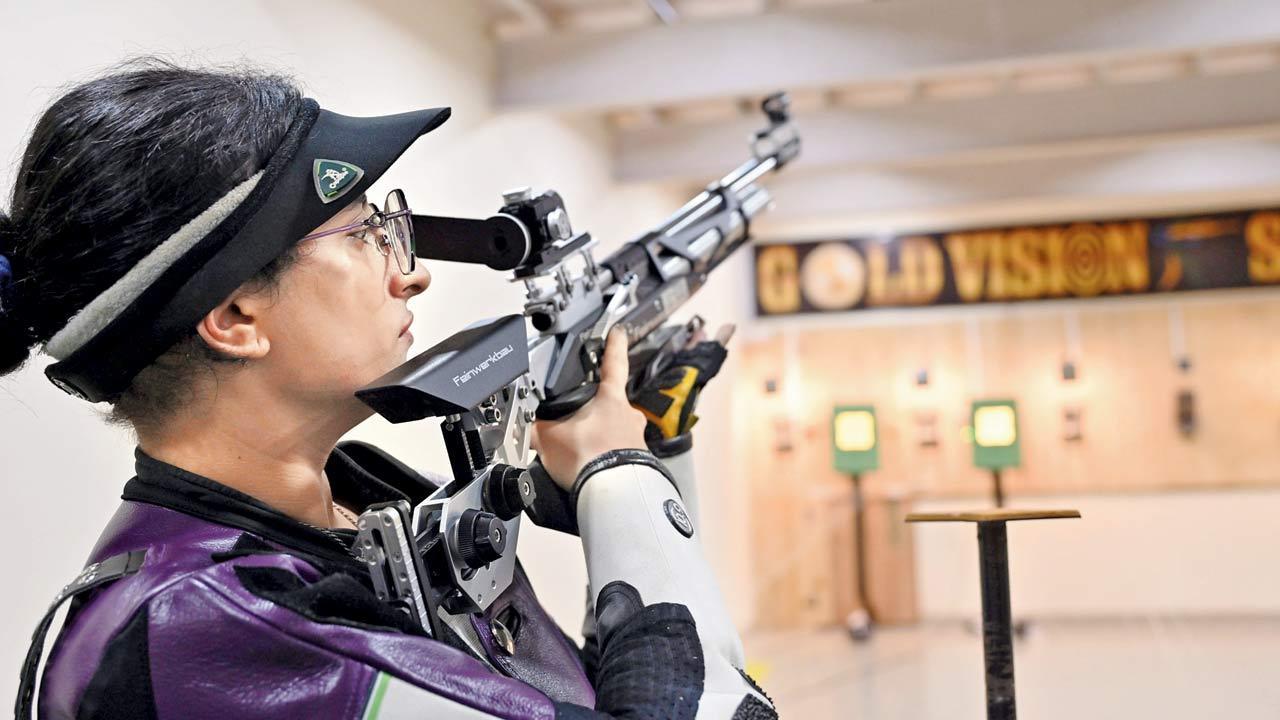
10m air rifle shooter Vahbiz Patel practises for up to seven hours a day at the Gold Vision Shooting Academy in Goregaon West, training her sights on a spot on the national shooting team. Pic/Atul Kamble
As Indian shooters make history at the Paris Olympics this month, bagging a best-ever haul of three medals, no one’s watching more keenly or cheering more loudly than the next generation of talent back home in India.
ADVERTISEMENT
Much of this young talent is from Mumbai, from where dozens of shooters have qualified for the nationals in the last few years. The city has long been renowned for its association with sports, predominantly cricket. Since the mid-2000s, however, there has been a noticeable surge in interest in shooting, and multiple shooting ranges began to mushroom across the length and breadth of the city. Today, the Mumbai Metropolitan Region houses around 20 shooting ranges. Most are equipped with state-of-the-art facilities and have seen a significant rise in participation from Mumbaikars over the years.
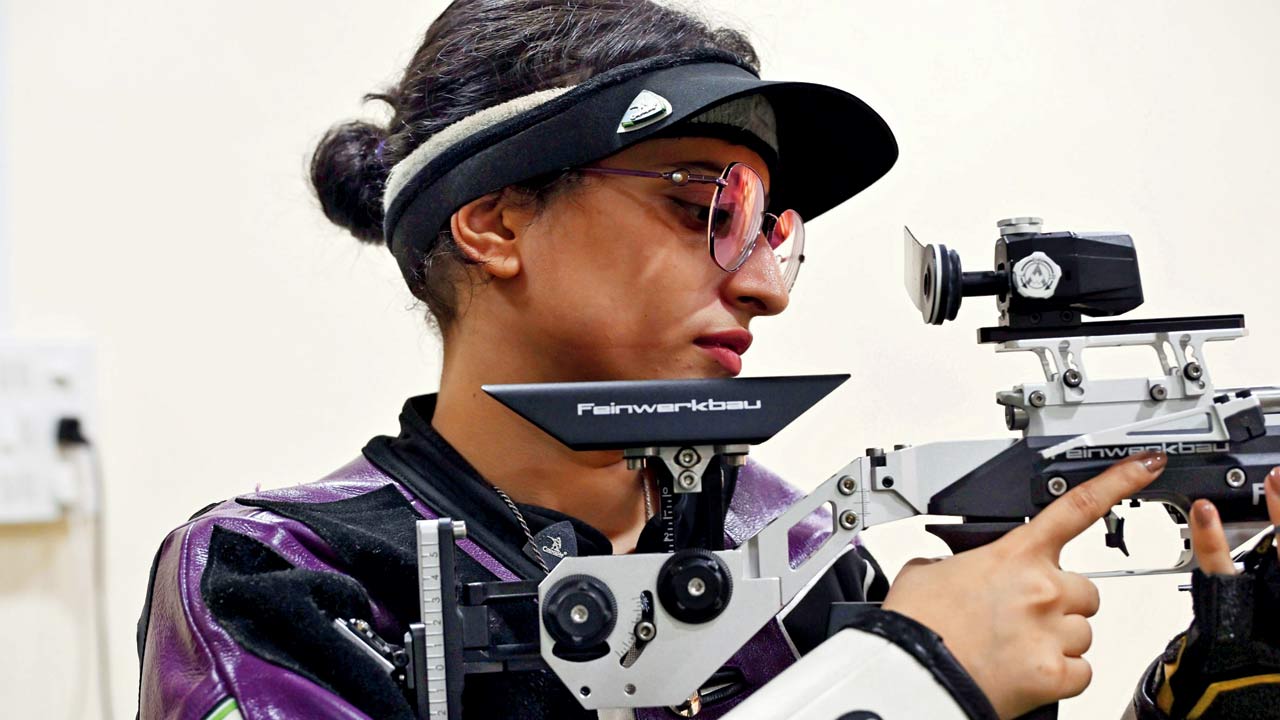 Vahbiz Patel, an emerging rifle shooter from Mumbai, currently preparing for national team trials, takes aim at Gold Vision Shooting Academy in Goregaon during practice. Pics/Atul Kamble
Vahbiz Patel, an emerging rifle shooter from Mumbai, currently preparing for national team trials, takes aim at Gold Vision Shooting Academy in Goregaon during practice. Pics/Atul Kamble
This burgeoning interest can be traced back to several shooters from the state rising to prominence in the early 2000s, such as former world number one in the 10m air rifle category Anjali Bhagwat, 2004 Olympic finalist Suma Shirur and Commonwealth medallists like Ronak Pandit. The recent success of Kolhapur shooter Swapnil Kusale, who became the first Indian to win a bronze in the men’s 50m rifle 3-position (kneeling, prone and standing) event on Thursday, is only likely to further excite youngsters in the city. Manu Bhaker, too, while not from Maharashtra, has inspired many women in the state with her feat of becoming India’s first woman shooter to bag an Olympic medal last week.
With comprehensive coaching being disbursed across the city, Mumbai shooters are currently training their sights on trials for the national team. One such promising talent is Parth Mane, 16, a 10m air rifle shooter who trains at Lakshya Shooting Club, run by ace shooter Suma Shirur in Navi Mumbai.
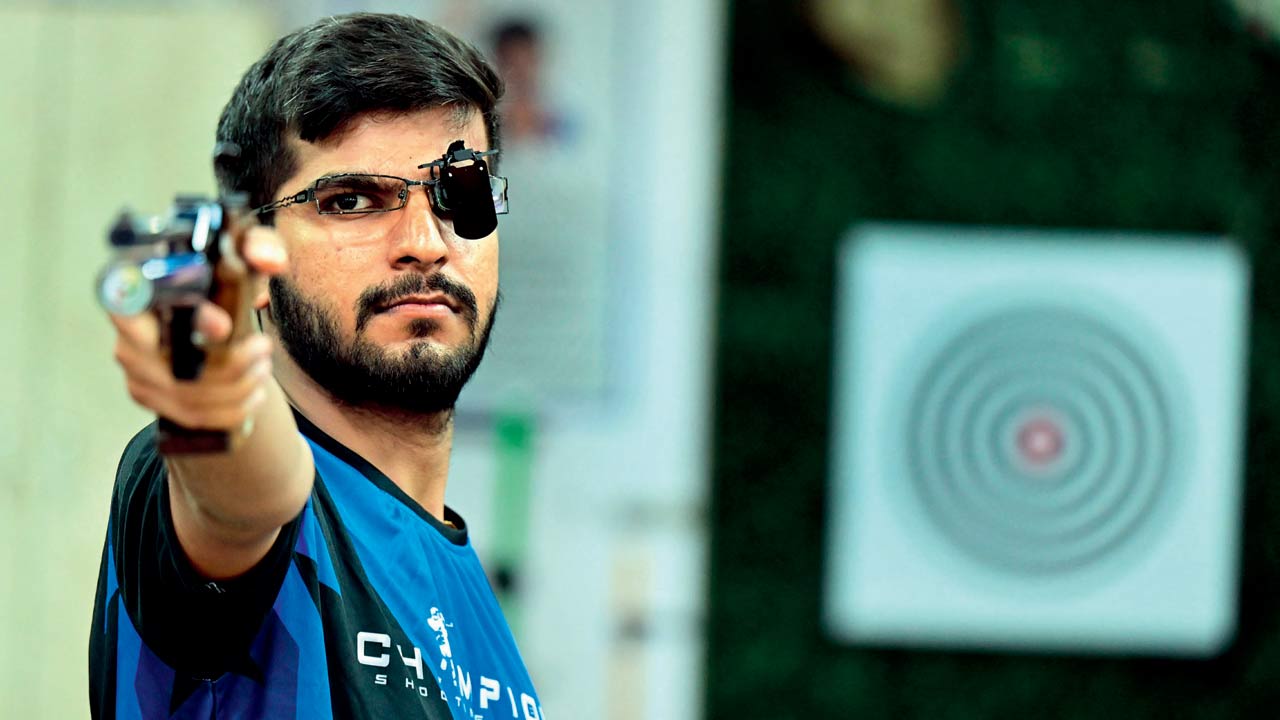 Nishank Jain, a pistol shooter at Champions Shooting Range takes aim with an air pistol during daily practice
Nishank Jain, a pistol shooter at Champions Shooting Range takes aim with an air pistol during daily practice
It’s a crucial year for Mane. Not only do his hopes to represent India at international competitions rest on his performance at the ongoing team trials, but the Class 12 student also has to prepare for his board exams in February 2025. After attending classes at Mahatma Phule Arts, Science and Commerce College in Panvel, the science student spends a minimum of four hours practising at the shooting range every day.
He’s been through this grind before. He recalls his Class 10 board exam preparations, saying, “Since I was training for international competitions then, I had to put in a lot of training hours a couple of months before the exams.” The Board exams are inescapable but, fortunately, for any other exams that clash with his matches, his school allows him to appear for them later.
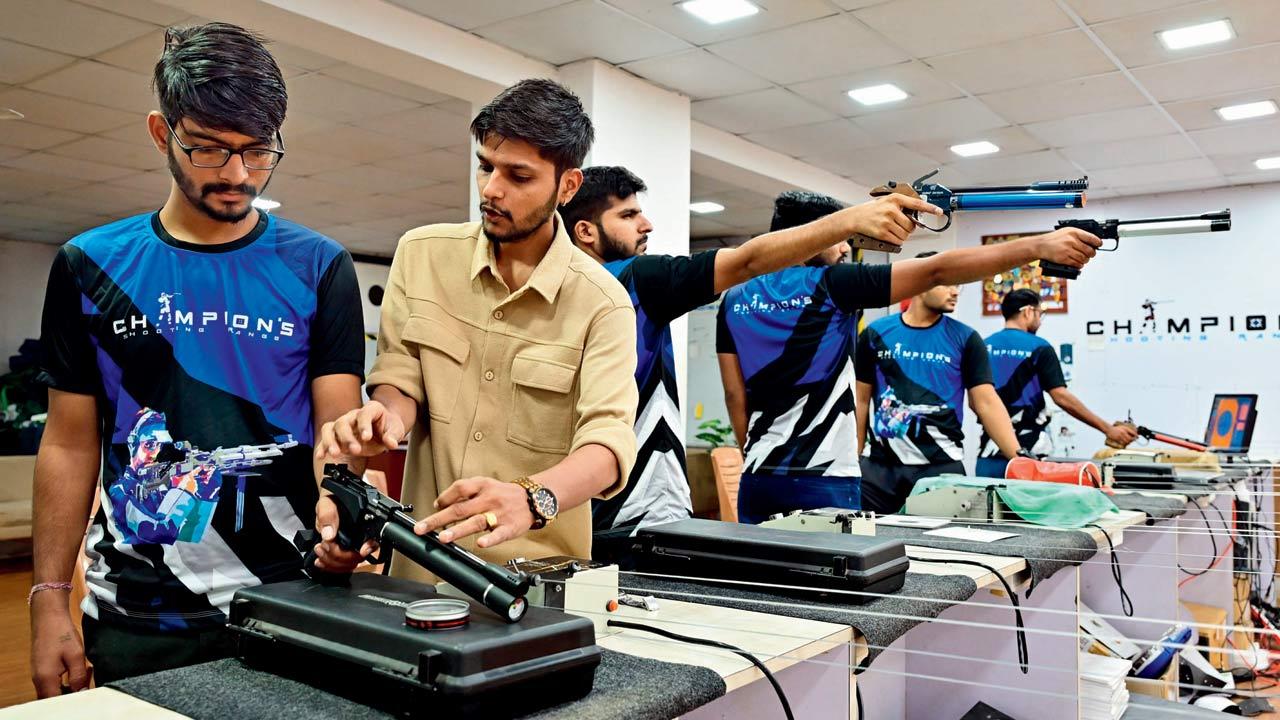 Ankit Jain, shooter and coach, during a shooting session at Champions Shooting Range, in Andheri East. He has been playing the sport for over thirteen years and has won over a dozen medals at national-level tournaments. Pics/Shadab Khan
Ankit Jain, shooter and coach, during a shooting session at Champions Shooting Range, in Andheri East. He has been playing the sport for over thirteen years and has won over a dozen medals at national-level tournaments. Pics/Shadab Khan
It’s a tough balancing act, but the effort has paid off so far. Since his first brush with the sport at a school summer camp eight years ago, the teenager has bagged individual and team gold medals at the Asian Airgun Championship 2022 in Daegu (South Korea), an individual silver at the ISSF World Cup 2024 in Spain, individual bronze and team silver at the Asian Shooting Championship 2024 in Jakarta (Indonesia), and team gold at the ISSF Junior World Championship 2023 in Changwon (South Korea), along with eight national-level titles.
“I started training in Solapur. When my father was transferred to Pune, I got to practise at the Balewadi Sports Complex, which is a much bigger facility. Then my father was transferred again to Panvel, where I have been honing my skills for the last three years,” he says.
 Kolhapur-based shooter Swapnil Kusale at the Paris Olympics, where he bagged a bronze medal on Thursday, bringing India’s total medal tally to three
Kolhapur-based shooter Swapnil Kusale at the Paris Olympics, where he bagged a bronze medal on Thursday, bringing India’s total medal tally to three
Although the government-run 80-lane range at Balewadi is larger, Mane says training has been more thorough in Panvel, where he gets personal coaching from Olympian Suma Shirur. “My routine involves physio sessions, workouts, mental routines, and a strict diet,” says Parth. The mental routine includes meditation and visualisation. While practising “visualisation”, he envisions himself perfectly aiming at 60 shots in upcoming matches. “That bit prepares me mentally for the matches,” he says, adding that he believes shooting is 90 per cent a mental endeavour, and 10 per cent physical and tactical.
His love for the sport is such that it “never feels like work” to him. “I don’t generally need time off. But after the [Team India] trials, there is an off-season period until the national games, during which there will be a break of around three months when no competitions will take place. I plan to relax for a fortnight then, before getting back to my training again,” he says.
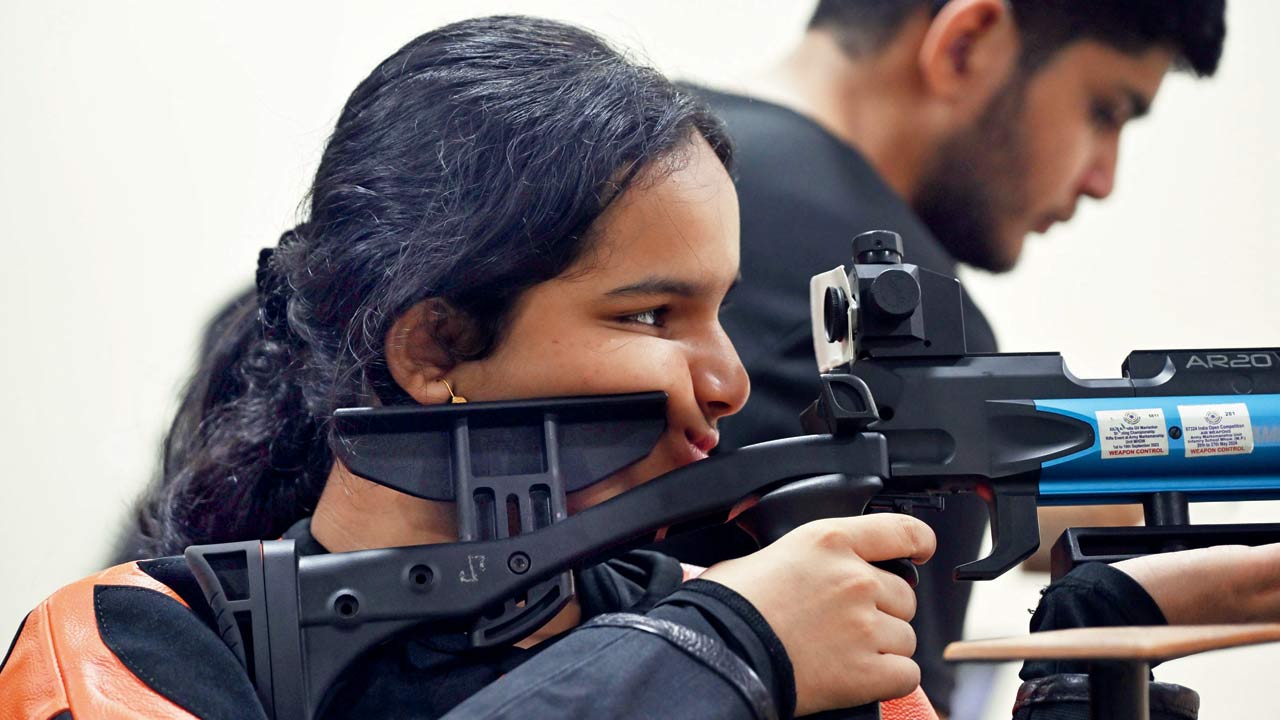 Mumbai-based junior shooter Ira Mahadik, a Class 9 student, takes aim at her shooting academy in Goregaon. She has been playing the sport for past two years and is competing at the state level
Mumbai-based junior shooter Ira Mahadik, a Class 9 student, takes aim at her shooting academy in Goregaon. She has been playing the sport for past two years and is competing at the state level
Despite his excellence in the sport and the support he has received from family, coaches, and his school, Mane feels that shooting sports in India have not received adequate recognition. “I am hoping this will change following the Olympics.”
Class 9 student Ira Mahadik, a state-level shooter who trains at the Gold-Vision Shooting Academy in Goregaon West, echoes this sentiment. “I feel that Maharashtra can significantly improve in shooting sports. The awareness about career-level shooting is low here, especially in Mumbai. I think Pune stands out as one of the best cities for shooting in the state. Here, the participation is good, but the level of seriousness is still lacking. If more people take the sport seriously, we can win more medals,” she says.
 Bronze medalists Manu Bhaker and Sarabjot Singh pose during the Shooting 10m Air Pistol Mixed Team medal ceremony at the Olympic Games Paris 2024. Pic/Getty Images
Bronze medalists Manu Bhaker and Sarabjot Singh pose during the Shooting 10m Air Pistol Mixed Team medal ceremony at the Olympic Games Paris 2024. Pic/Getty Images
No city becomes a sports hub without great coaches, and Mumbai has its own set of dedicated athletes and coaches who have strived to discover and hone the best talent. When shooting started to pick up in Mumbai in the 2000s, two stalwarts— Dronacharya awardee Sanjay Chakravarty and former Maharashtra Rifle Association president Bhishmaraj Bam—are credited with honing some of the state’s—and India’s—finest talent.
Chakravarty trained ace shooters such as Abhinav Bindra, Gagan Narang, Bhagwat and Shirur, as well as Deepali Deshpande, Anuja Jung and Ayonika Paul. He also served as India’s national coach in his career spanning 40 years. Bam, who was a sports psychology expert, also worked with India’s ace shooters right up to the Olympic level. Under their tutelage, Maharashtra produced seven Olympians between 2000 and 2016.
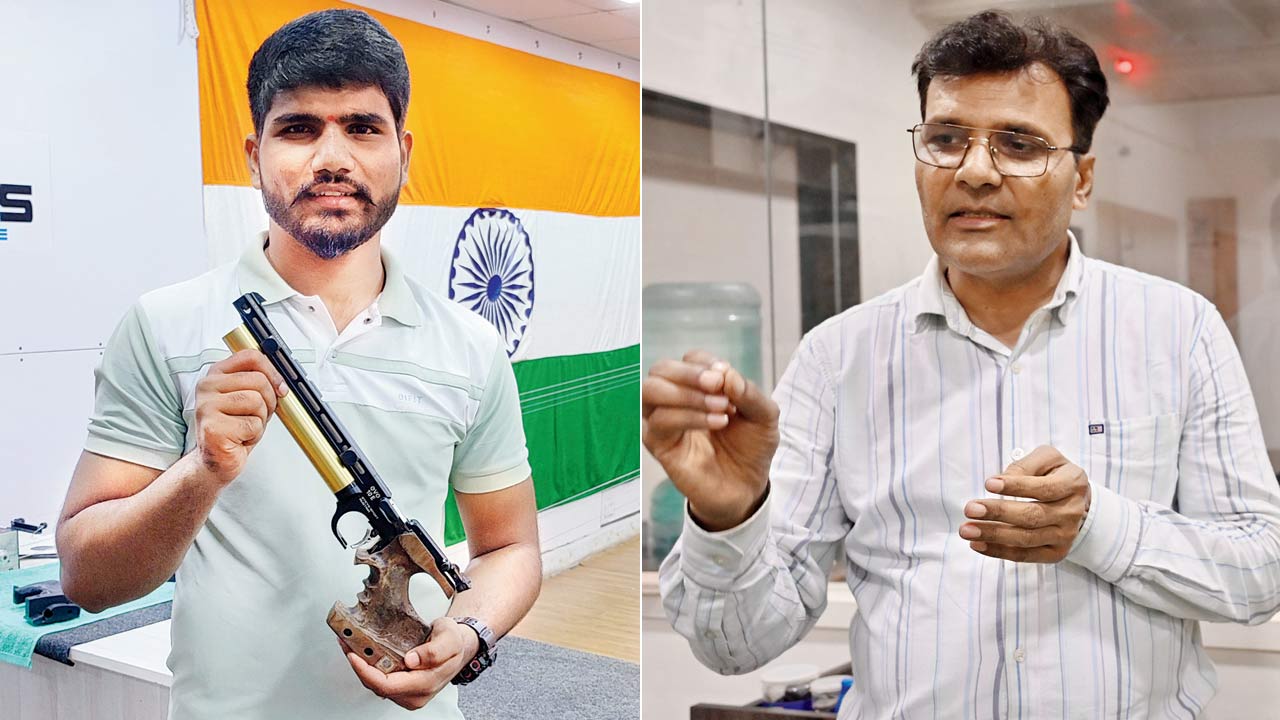 Chandrashekhar Dake and Coach Pritam Singh
Chandrashekhar Dake and Coach Pritam Singh
Many of their protégés have gone on to establish their own shooting ranges and are now coaching the next wave of talent. Lakshya Shooting Club, run by 2004 Olympic finalist Suma Shirur and her husband Siddharth Shirur, has produced several national-level players from Navi Mumbai.
Siddharth discovered an interest in shooting through his wife. An architect by training, today he also manages a network of shooting ranges in Navi Mumbai. The shooting scene in Mumbai and Navi Mumbai is pretty much run by private enterprises, he says, except for the Maharashtra Rifle Association’s (MRA) range at Worli.
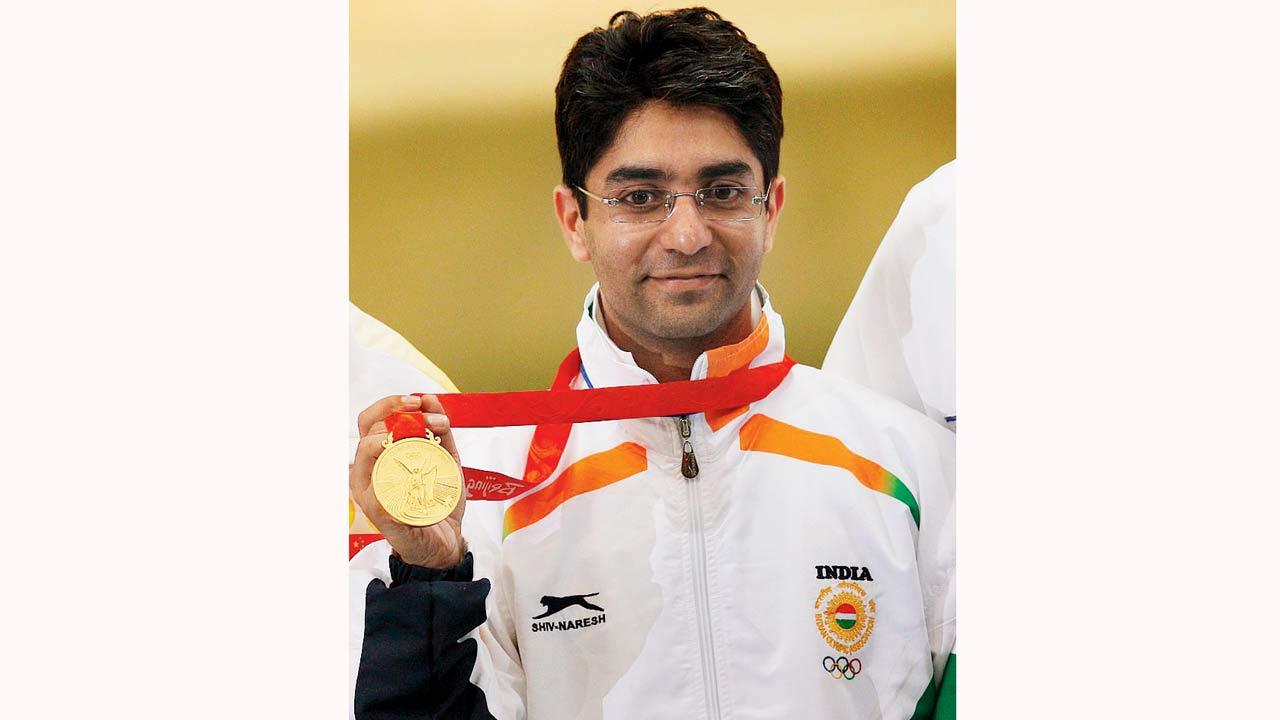 India’s first Olympic gold medallist Abhinav Bindra after winning the men’s 10m air rifle shooting finals for the 2008 Beijing Olympic Games. Pic/Getty Images
India’s first Olympic gold medallist Abhinav Bindra after winning the men’s 10m air rifle shooting finals for the 2008 Beijing Olympic Games. Pic/Getty Images
The MRA range is one of only two full-fledged venues in the state that offer 50m air gun ranges. The other is Pune’s Balewadi Sports Complex, which is one of the biggest set-ups in Maharashtra and also features a high-tech trap shooting range. Balewadi is where Swapnil Kusale had trained for the 50m category ahead of the Olympics.
Thanks to high cost of real estate in Mumbai, most centres in the city have 10m ranges. An official from the Maharashtra Rifle Association explains that establishing new 50m shooting ranges in Mumbai is particularly challenging because of lack of available space. “It is really difficult to set up a new 50m range in Mumbai as there is no open space that can accommodate it. The range we have in Worli was established approximately 70 years ago, when land rates were cheap. Today, it would require an investment of hundreds of crores just to acquire land for the range,” says the official.
 K Sultan Singh, secretary general, NRAI
K Sultan Singh, secretary general, NRAI
Private ranges have given a much-needed fillip to the sport, along with the efforts of the National Rifle Association of India’s (NRAI) role in bringing visibility to the sport, says Shirur. “They [NRAI] have facilitated the setting up of many ranges across the country, and they never say no to any club coming up. Initiatives like Khelo India [a government programme to revive sports at the grassroots level], which started in 2018, are helping a lot of underprivileged kids pursue shooting sports,” he adds.
Shirur recalls a time in in the mid-2000s, when their academy had not yet been established and his wife was training for international competitions. “Around 20 shooters would come to our house to train for around eight hours a day. Their coaching would happen simultaneously. Now, there are over a dozen shooting academies in MMR, with ultra-high-tech ranges in the Vasai and Virar, too. This became possible because of a mix of private and government enterprises,” he says.
K Sultan Singh, secretary general, NRAI, told mid-day, “You also have to look at these sports from the point of view of compliances of Arms Act and state’s law and order issues.”
“The ranges have to be supported by trained and certified coaches, mind trainers and other support personnel. It’s not a regular sport like football or cricket. Many government permissions are required to set up a range and acquire firearms, too. If there is ever a proposal to set up a bigger range in Mumbai, where even shotgun sports can be played, NRAI would definitely support the state associations and the clubs from all perspectives. But the association’s role comes only after all the permissions are granted by the state government,” he says.
Real estate is not the only financial hurdle faced by shooting, which is counted among the most expensive sports in the world. The entry barrier for shooting is much higher compared to other sports due to the cost of equipment and the need for proper facilities. “If you play cricket, you can do jugaad and use bricks as stumps at the beginner level. You can practise in the gullies. But shooting requires sophisticated equipment and a proper venue,” says Shirur.
Aditya Rastogi, a 10m air pistol shooter and coach, explains the cost factor: “One can rent a gun at R7,000 per month in air pistol shooting, while the rental rates for air rifles vary from R12,000 to R60,000 per month. The most expensive is shotgun sports,” says Rastogi, calling it a sport of Maharajas. “Training costs for trap shooting can go up to R1 lakh per month if one trains six to seven times per month, which is low frequency,” he adds.
Rastogi, who hails from Meerut but has been training students in Mumbai for over three years, says space and a thriving gun culture is why more shooters from North India have made it to the top. “There are more gun ranges up North. Plus, there is the advantage of private farms, where people can practice.”
National-level shooter Ankit Jain, who has been competing in the 10m air pistol category since 2011, agrees with this. “Anyone who has the privilege of a personal range will become twice as good at the sport because of 24x7 access to a training venue. In Mumbai, shooters in the suburbs have it tough, since it’s not easy to travel to MRA’s 50m facility in Worli,” he says.
This is the reason why most kids who pick this sport hail from middle-class backgrounds, he says. “A sport like shooting requires equipment and formal coaching. Kids from weaker economic backgrounds are more likely to pick sports for which the least amount of equipment is required, like Taekwondo or football,” he adds.
Jain, who has won over a dozen medals at the state and national levels, is also the owner and coach at Champions Shooting Range at Andheri East, Powai and Chembur. On the operational aspect, he explains, “Opening a private academy requires multiple permissions from the forest department, as there is a forest in close vicinity in Mumbai (Aarey). The range owners also need permission from the local police station. Both these processes are smooth in Mumbai if the intent is right.”
Jain had started the academy with just seven students in 2018, but now, each of his ranges are brimming with around 40 students, children and adults alike.
Jain emphasises that shooting might seem easy, but the muscles should be acclimated to long exposure to strain and stress as one needs to stand absolutely still in fixed target shooting. “One must practise sports like gymnastics and yoga, which build muscle endurance,” he says.
Many kids who join his academy are inspired by action movies. “Some even ask if they can shoot with both hands, like John Wick,” he laughs.
Most kids, though, join the sport because of Abhinav Bindra, who made history when he won the men’s 10m air rifle competition at the 2008 Beijing Olympics, becoming the first Indian to win an individual Olympic gold medal in any sport. Ask any young shooter who their inspiration is, and they’ll likely name Bindra.
National-level player Vahbiz Patel, 21, is no different. “I was inspired by two shooters—Bindra and Ivana Maksimović Anđušić from Serbia, who won silver at the 2012 Olympics. I watched them on TV for the first time when I was just five years old,” says the 10m air rifle shooter who is also pursuing a correspondence college degree from Mumbai University.
“Even if I weren’t enrolled in a correspondence degree, I would still be practising five to seven hours every day,” she says.
Struggle is inevitable, and even Kusale and fellow medal-winners Manu Bhaker and Sarabjit Singh had their own share of it before winning at the Paris Olympics. The Indian shooting team’s triumph comes after a medal drought in the 2016 Rio de Janeiro and the 2020 Tokyo Games. “A shooter’s journey is a series of defeats before tasting victory. We have been following Bhaker’s and Kusale’s efforts at other tournaments. Their persistence, despite past defeats, inspires us. No medal at the competition doesn’t break a shooter’s spirit. We keep going,” says Patel.
She is one of five students from Gold Vision Shooting Academy in Goregaon West that are currently appearing for the national team trials. The range’s owner and coach, Pritam Singh, says Mumbai has plenty of potential, highlighting that 18 of his students have qualified for national-level tournaments. But the potential is not necessarily being harnessed to the optimum level.
“Given that Maharashtra has plenty of infrastructure and capital, it can aim for more medals. But most students who pick up shooting here see it as a leisure activity, rather than a career. In northern states such as Punjab, Haryana, Delhi, UP and Rajasthan, on the other hand, the gun culture is more serious,” Singh adds. Singh is now considering setting up another gun range in a village 35 km from Pune, as he believes shooters in rural areas are more serious about the sport. “Most medallists in India are from rural areas or small towns and cities,” he points out.
“Kids in smaller towns and cities, like Kolhapur, Nashik and Sangli, spend much more time honing their skills and are much more serious about the sport as they don’t have as many distractions as Mumbai kids do. What’s required is more awareness about the sport in the state,” he adds.
Many coaches agree that while fostering gun culture is adverse to society, but it’s also perhaps why the Northern states, where gun toting is common, are more serious about shooting sports.
National-level shooter and coach at Champions Shooting Range Chandrashekhar Dake says, “Many people in cities like Mumbai refrain from putting their kids in shooting sports because they think it may make them violent. But shooting is neither violent nor aggressive. It is like meditation; it can calm people down. A lot of people with anger issues join this sport.”
Originally from Solapur, Dake trained at Pune’s Balewadi range for a couple of years before winning at the nationals, and eventually moved to Mumbai to coach youngsters. He says there is plenty of talent in Mumbai, but that comes along with plenty of distractions, too. “Junk food is available everywhere, and there are many other options for co-curricular activities,” he says.
Jain adds, “Some kids join shooting sports just for the certificates, to pad up their resumes for college admissions.”
Lakshya co-founder and secretary Shirur also highlights a cultural aspect that affects sports participation in Maharashtra. “In Maharashtra, sports take a backseat and academics take precedence. Up north, sports’ prevalence is higher. Here [Mumbai], you could play any sport, but one question is always asked: ‘But what are you studying?’ Most kids start shooting at the age of 10, which is the minimum official age to participate in competitions. Many drop out of the sport at ages 12-13 because of Class 10 boards. In Southeast Asian countries, a lot of medallists are between the ages of 15-20. This is the exact age in Maharashtra when children stop going to ranges due to academics,” he says.
That’s not to say that sportspersons should ignore academics. Not everyone can make it to the Olympics level, and education is a must so the players have a back-up option, he says. “I believe studies are important, and one must get their bachelor’s degree, but one can still pursue sports simultaneously,” he adds.
20
No. of shooting ranges in MMR
A series of firsts
. Manu Bhaker opens the country’s account at the Paris Games on July 28 with a bronze in the women’s 10m air pistol event, becoming India’s first woman shooter to bag an Olympic medal
. Bhaker and Sarabjot Singh win a Bronze in the 10m air pistol (mixed team) event on July 30, making it India’s first medal in team shooting
. Bhaker also becomes the first Indian since Independence to win two medals at the same Olympics
. Swapnil Kusale becomes the first Indian to win an Olympic medal in the men’s 50m rifle 3 positions event on August 1
. This is also the first time India has won three medals in one sport at the same edition of the Olympics
Shoot, that’s expensive!
The cost of training depends on several factors, such as the type of shooting (rifle, pistol, or shotgun), the level of coaching, and the location of the training facility.
10m category: Renting an air pistol can cost approximately R7,000 per month while air rifles can be rented for Rs 12,000 to 60,000. Rifle shooting also requires a body suit and other equipment.
25m category: Gun users in this category require a formal sporting licence. The gun’s rent is also higher, at Rs 15,000 per month. Buying a gun can cost anywhere from Rs 80,000 to lakhs of rupees.
. There are also other expenses such as coaching fees, range fees, diet plans, and costs associated with participation in competitions, which can rack up a total cost of up to R40,000 per month at minimum
 Subscribe today by clicking the link and stay updated with the latest news!" Click here!
Subscribe today by clicking the link and stay updated with the latest news!" Click here!







